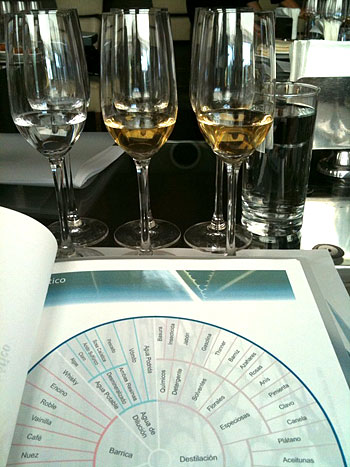It’s 11 a.m. on a Tuesday and I’m sitting in La Tequila, the largest tequila bar-restaurant in Guadalajara. The older gentleman sitting next to is holding a small glass vial to his nose and smelling deeply. He looks at me, shrugs, and hands me the vial. I know this one is going to be a tough one.
It’s Day One of a four-day hardcore seminar on tequila tasting and evaluation and almost everyone is having a hard time identifying the unmarked smells in the little glass vials. We have to identify what aroma group the smell comes from—floral, herbal, spice, fruit or other—and name the smell if we can. I take the vial the man has passed to me and take a deep whiff. It’s floral … no, it’s punchier than that. An herb? I write down “herbal” but I have no clue what kind. I move on to the next one.

The Tequila Aroma Wheel, with six glasses of tequila behind it – day #1 of the tequila tasting class in Guadalajara.
For this website, I have tasted a lot of tequilas. I always try to be observant and descriptive as possible about the tequilas, but I realize I’m no expert. Tequila is complex. It has over 600 possible aroma and flavor components. Some, like vanilla and caramel, are easy to spot because they come from the barrel and are present in many aged tequilas. Others, like apples, gardenias and solvents, are more challenging. Is it baked apple or fresh apple? Is it thinner or is it gasoline? These are things that expert “catadores” (tequila tasters) can identify immediately.
Luckily, I’m taking this seminar from one of the best catadores around. Her name is Ana Maria Romero Mena and although she doesn’t talk about her work in depth (she’s been focused on teaching us) it is obvious that she has consulted and worked with many of the big name tequila brands and has educated people in all parts of the industry on how to develop aromas and conduct a proper cata (tasting).
In my mind she would be the perfect tequila fixer. Does your tequila taste or look a little funky? Are you having problems capturing the floral aromas you want and eliminating the solvents? Ana Maria can look at your tequila, smell it, take a sip and tell you what part of your process is producing the undesirable elements and what you can do to fix it. If you are designing a new tequila, she can tell you what you have to do technically to achieve a certain flavor and aroma profile.
I am very fortunate to have her as a teacher, and to have been recommended to her by David Yan of Casa Noble. I am the only person in her class to not be a tequila industry exec (except for a tequila historian). I’m also the only native English speaker and my rusty Spanish is getting a serious workout.
After flailing in the aroma test on Day One, we talked about the difference between sense and perception (sense is your body’s immediate reaction, whereas perception is your analysis of the sensation.)
We also learn that when it comes to how you judge a tequila, 15% of your perception is visual, while 60% of your perception is based on smell and 25% is based on taste. Let me say this again—60% is smell! Imagine how important it is to cultivate pleasing aromas in a tequila, and how important it is for tasters to be able to identify and categorize those aromas. Unfortunately, for most people (like me) the olfactory sense is the least developed. This is partly because most of us live in cities and rarely have the chance to smell a variety of fresh flowers, herbs and products of the earth. We also tend not to cook at home as much as people did in years past. Cooking at home gives you the opportunity to smell each individual ingredient. For instance, in the first day of class we smelled five or six different herbs and identified all the separate aromas that made up that herb’s particular smell. When was the last time I truly smelled rosemary and detected the floral qualities, the nuttiness, the black pepper, the anis? Never. But I will now.
At the end of the first day we did a cata of six tequilas: two blancos, two reposados and two añejos. Aromas started to emerge that I had never perceived before: olives, peaches, anis, and yes, rosemary.
So, my advice to you tequila lovers is to sniff and assess every herb, fruit and vegetable in your kitchen. Taste and re-taste all your tequilas. Train your nose. I know that’s what I’ll be doing.
(Stay tuned for part two of my notes on what part of the tequila making process generates certain aromas and flavors.)
-Scarlet






Hey Scarlet, first off gotta say love your website and blogs. Second, I am wondering do you have any information on this class you are taking? I would love to know more info like where in Guadalajara is it? Can anyone take this class or do you have know someone to get in?
-jas
Hey Scarlet, I know you guys use to live in San Fransisco and well I’m going next week was wondering what was the best liquor store to find some rare tequilas.
Hi Scarlet, I’m feeling jealous reading about the wonderful experience that you’re having! Information on how and where some of us tequila afficionados can partake in a future course such as the one you’re enjoying would be very much appreciated. Please post some future event details if you can. Muchisimas gracias! Salud! :)
-Erica
Excellent reporting, Scarlet!
It’ll be interesting to see if your preferences for certain tequilas will change as a result of your being able to identify more clearly exactly what you’re smelling/testing — or whether you’ll just fall more in love with your current tequila preferences now that you now exactly what’s in their bouquets/flavors.
Can’t wait to keep reading!
-Lippy
Wonderful to see this “connection” just made your inner fire grow in intensity for your passion towards tequila. There is no going back now Scarlet! Enjoy every minute of it, because now you will never see tequila the same way you did a week ago and before. For all of you who want to get into other Ana Maria´s courses, drop me an email and I´ll help you with that.
..OH! and Scarlet: you are still coming to my house for some serious tequila boot camp, ok!
DY
Scarlet – You and Grover always do a great job, but this has to be your most interesting article yet. This class sounds amazing! I’ve done a bunch of wine tastings and a couple with scotch, it’s very interesting how your palate can “mature” in such a short time with proper education. I need to find something like this here in AZ. Can’t wait for Part 2. Loving your site!
Thanks for your great feedback! I have another post or two about the class coming, so stay tuned.
Also, for those of you interested in a class like this (at least in Mexico) David Yan from Casa Noble kindly offered to pass on your info to Ana Maria. His email is: lirubis@yahoo.com
Thanks, David!
[…] Tequila Tasting 101: It is All In The Aromas […]
Scarlet,
really enjoying these posts (101 & 202). Have been coming back to them- lotsa good info!
gracias!